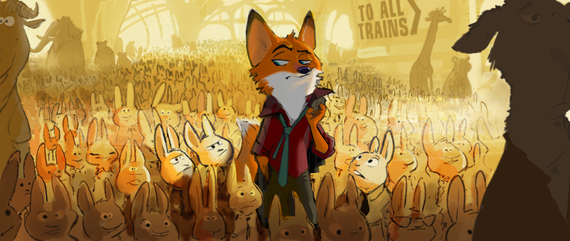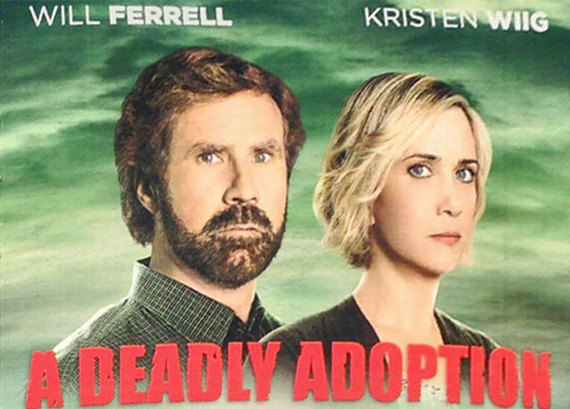This ongoing column series looks at some of the art that generatively confused us in recent months because it was, for a change, metamodern rather than discretely Modern or postmodern. To find out more about the metamodern principles the artworks (and people) below explore, see the two-part series on metamodernism (I; II) previously published in The Huffington Post.
The first entry in the "Month in Metamodernism" series can be found here.
The production of nostalgia for a past that no one actually experienced is distinctly metamodern. The video game series Fallout has been exploring this territory for years. A post-apocalyptic landscape whose soundtrack is taken from 1930s/1940s musical group The Ink Spots? Flashbacks to a version of the 1950s that never existed, but which the player nevertheless longs for as they walk through the futuristic ruins of Boston? The Colonial artifacts of Boston, retrofitted with near-future technology? Yes, very metamodern. And gripping as hell. Video games have never looked this beautiful, nor transcended time so well.
Should Earth -- that is to say, the people Earth in their totality -- have their own flag? Some say "yes," given the possibility that humankind's increasingly international forays into space may yet lead to contact with alien life. To read about this project and see the flag that it proposes for All of Us feels simultaneously uncanny and entirely sensible. It's like the first pages of the Star Trek saga. Are we the Federation Alliance now? Well, in a sense, yes -- we're already there. Read more here and see a video on the project below.
Want to step inside a music video? Now you can. As Stereogum explains, the line between video art and lived reality has been erased by this pioneering "3D VR" music video from Björk. (If for any reason the 3D navigation won't work on your YouTube browser, click on the link above in this paragraph to watch the video at Stereogum. I promise you won't be disappointed.)
Okay, now how'd you like to step inside a painting? Well, the Immersions Project lets you do just that -- go inside an artwork. Literally. Watch below and be amazed.
We're not done yet. How'd you like to fly through an actual nebula?
Some things are so cool that it takes a moment to process exactly why they're so great. The video below won't at first "land" with most people -- it didn't with me, either -- because like all of you I've seen the same thing we see in the video below a) in sci-fi movies, and b) in CGI videos, a million times before. Which perhaps lends this sort of video its metamodern quality: the fact that it's underwhelming until you really process that what you're seeing is real. And it is: real, that is. This is a 3D rendering of something that actually exists and was "seen" by means of artificial (human-built) intelligence -- not a visual reproduction of a thing. But it still feels fake, which perhaps is the magic of it. More here.
Mashups are metamodern. They don't deconstruct (a la the postmodern), nor do they imagine that entirely "original" constructions, i.e. those purely the product of superlative genius and unique insight, are still necessary (long a Modernist imperative). Instead, mashups take pieces of already endlessly deconstructed material, like clips from over-analyzed films, and reconstruct them into something that coheres on its own merits. Such reconstructions are partly ironic, because we can't help but compare a reconstruction to its original components and trace the distances between them, but are also entirely earnest, as they attempt to construct new, cogent narratives with their own characters, plots, and atmospherics. "Re-art" is thereby, at once, entirely creative and entirely a reaction to pop-cultural artifacts of the past. And so it is with Akbar's 11, a mashup of -- well, you can probably guess. See for yourself below:
Speaking of mashups, is Disney getting in on the action? Its upcoming 2016 film, a fox-and-rabbit buddy movie, has observers seeing in its artwork and plotline a combination of Robin Hood, The Fantastic Mr. Fox, 48 Hours, Kung Fu Panda, Blade Runner, and Richard Scarry cartoons. That string of imagined influences is likely a bit of a stretch, but consider this: Disney has only rarely, in recent decades, created films in which animals are the only living organisms, let alone where animals dress like humans and live in a futuristic world entirely particular to the film in which it appears. So there's certainly something strange afoot here.
Perhaps it's no surprise, then -- as we often see disagreements like this with metamodern artwork -- that two of the three AMC experts in the clip below call Zootopia "entirely new," even as so many others are seeing how all its pieces seem to be drawn directly from other artworks:
In Back to the Future II (1989), Robert Zemeckis assured us that hoverboards would exist in the year 2015. He made this assurance at a time when the world didn't even have email yet. Well, turns out he was right: it's 2015, and commercial hoverboards exist. Below, you can watch no less a boarding icon than Tony Hawk ride one.
The so-called "Hendo," in view of its presaging by Zemeckis, is an amalgam of deliberately zany technetronic fiction and (now) seemingly enlightened scientific speculation that metamodernists would deem very Zavarzadean -- as it's clear very little thought was in fact put into any of the B2tF2 "predictions." The crazy part? Zemeckis and his crew got six other ridiculous predictions right as well. We expect this sort of accurate divining from tech visionaries, not from cinema pulp.
It's a month for mashups, apparently. This one is a little different because it takes Game of Thrones and, well, basically every current player in the NBA, and attempts more an overlay of one mythology atop another than a mashup proper. But it's even stranger than that, as it's often not entirely clearly which material is being drawn from Game of Thrones -- at least beyond its atmospherics. Occasional references to the much-loved HBO series pop up and slide by almost as if the makers of this ongoing film series don't really care whether you get the reference or not. In this sense, Game of Zones is more metamodern than some of the other mashups this series has featured, as it's really just using an existing atmospheric "template" to make actually-pretty-earnest critiques of players, trades, and teams in the National Basketball Association. Watch for yourself, and see what you can make of it:
One of the cool things about metamodern art is the uncanny way it eliminates our conventional reality/artifice interface. Real things seem unreal, and vice versa. In fact, this is so much the case that the question of reality comes to seem beside the point -- as facts and fictions become merely tools for the creation of new and (again) decidedly uncanny art. So while the North Korean propaganda videos below (discussed more on io9) are "real," they also exist in a metamodern space in which one really need not credit anything they are, or say, or contend. Fighter jets firing missiles at nothing? Publicly released videos detailing... er... future "surprise attack" plans? Poorly written, pathetically hyperbolic scripts intended to convey strength?
North Korea's tyrannical government is the ultimate metamodern political structure because it no longer cares whether anything it says is believed or not. Consider: it recently told FIFA (the governing body for international soccer) that the reason every member of its women's soccer team tested positive for steroids is because all of them were hit by lightning and had to take deer musk treatments to heal. Yes, seriously, they said that. Straight-facedly. FIFA was not amused, which is why you won't see North Korea in the 2015 Women's World Cup -- despite the country's squad being ranked eighth in the world and having beaten 2011 World Cup champion Japan in the title match of the recent Asian Games.
Is this a short film, a music video, or both? It has all the sincerity of Glee (at least the "live-concert" parts of the show) but also a desire to create something new rather than merely re-record something old. What Donnie Trumpet & the Social Experiment have given us here is really a mixed-genre musical rather than merely an earnest send-up (oxymoron intended) of one genre or another, as we find in Glee. I'm still not entirely sure what to make of it all, but somehow it's clear that this isn't the sort of music video we've come to expect. "Sunday Candy" deconstructs the high school play without feeling in any sense deconstructive -- let alone ironic. In this sense, it's very much a metamodern reconstruction.
Is Shamir Bailey "post-gender"? Somehow "trans-human"? Certainly, there's something uncanny about this incredibly talented young man; his work doesn't seem to fit well into any category, nor does his public image. Pitchfork spent some time with him and it's an eye-opener. Watch the two videos below to get a sense of what we're talking about here:
Who secretly -- and implausibly -- films a movie for Lifetime, releases news of the secret filming on April Fool's Day, and then, when the actual fact of the movie is revealed, not only denies being involved in the project but denies that the film will be released? Only to have that turn out to be a lie also, because the film will be released?
Will Ferrell. And Kristen Wiig.
The two comics made their involvement in the Lifetime movie A Deadly Adoption almost impossible for the media to report upon because the name and plot of the movie, plus the involvement of actual stars Ferrell and Wiig, made it impossible for anyone to credit. And Ferrell's deceit compounded the problem.
But guess what: the movie is real, and coming on Saturday, June 20th (Saturday being an unusual date for a Lifetime release, yet another reason the whole thing was long thought to be a hoax). Ferrell and Wiig have thereby one-upped metamodernists Joaquin Phoenix, Crispin Glover, and Shia LaBeouf by actually doing something and pretending not to do it, rather than (as is much more common) not doing something and then having pretended to do it. Got all that? Well, it's textbook metamodernism: a testing of the reality-fiction matrix which is deliberately impossible for either individuals or institutions to readily navigate.
Rolling Stone has more here.
One of the richest men in America is someone regularly made fun of for his (presumed) hairpiece. This man, widely considered among the most vain in the country, is aware of the open question of his cranial status -- indeed has almost certainly read detailed analyses of why his hairdo is perpetually under suspicion -- and yet never changes his hairstyle. This, despite access to the best hairdressers in the world. Meanwhile, he runs a Twitter feed simultaneously so outrageous and in keeping with his personality that the nation is split on whether he's a narcissist, a performer, a performative narcissist, or a narcissistic performer. It seems like he wants us to not understand his existence. To be perpetually in awe/confusion/annoyance on the question of what the hell he is, exactly.
Well, in two weeks he's probably going to announce that he's running for President of the United States.
Everything Donald Trump does calls to mind Ross Perot, the darling of the "Reform Party" in the 1990s. Perot, another metamodern(esque) "politician," was a man so resolutely and openly corporatist that his folksy demeanor and easy appropriation of well-understood capitalist gestures (remember his political "infomercials"?) convinced many -- possibly correctly -- that he was, in his own slightly creepy way, earnest.
If Ross Perot was the unperfected, proto-metamodern politician, Trump is one version of the perfected edition. While it looks increasingly likely that his mid-month announcement will be "all systems go" for a presidential run -- after all, he's already statistically tied for second in New Hampshire, according to Real Clear Politics -- it's still possible Trump is toying with us all. Either way, the June press conference Trump has planned is a win-win scenario for both observers of the metamodern and, of course, Trump himself: just being speculated about in this way has already enormously increased Trump's personal wealth. (Which was likely the reason he conducted this particular public striptease the first two times, too, in 2008 and 2012 -- only to go back to his failing NBC show The Apprentice each time).
And yet, in keeping with the system of logic that governs the metamodern, we also suspect that a) Trump really would like to be President, b) really does believe he'd be good for the country, and c) actually does hold policy positions which, whether earnest or cynical or (and this is actually for certain) dangerous to the country, in fact do speak to an appreciable percentage of the American electorate -- though, admittedly, a justly marginalized fringe.
If we remember that metamodernism does not make of a man or woman a good or bad politician or person -- it merely helps explain their particular place in the public cosmos, and our particular fixation on them -- Trump's June 16th announcement of his presidential ambitions becomes a banner moment for metamodern critics and scholars worldwide.
[Side note: Anyone think the metamodern band "Donnie Trumpet" -- above -- is a sly reference to the metamodern human "Donald Trump"? The plot thickens.]
Anyway, here's Trump giving a lengthy interview for the top television station in New Hampshire, WMUR, just a few months ago:
[Scroll down at this link for more essays on metamodernism.]
Seth Abramson is an Assistant Professor of English at University of New Hampshire and the Series Co-Editor of Best American Experimental Writing, whose next edition will be published by Wesleyan University Press in late 2015. His most recent book of metamodern verse is Metamericana (BlazeVOX, 2015).


